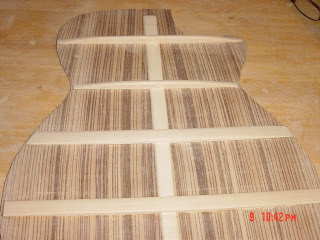I've not done any research or any testing, but I find myself in agreement with the latter school. The back is made of hardwood and is not as flexible as the soundboard. It is not designed to vibrate as much as the top. It does vibrate, however. Hold a guitar and strum a full chord and you can feel the sound against your torso. And you can hear the difference between a guitar made of rosewood and one made of maple or some other hard wood, so there is no doubt that the back (and sides) contribute to the sound. But it seems to me that you would want to minimize the vibrations coming from the back. Resonances can cancel each other out, and it seems that this is what would happen if there was a lot of vibrating going on.
If you want to bounce high on a trampoline, you keep your body rigid so that all the energy from gravity is transferred to the springs. When you want to stop and get off, you flex your knees and allow your body to absorb the energy. It seems to me that this is a good analogy for what I want to happen inside the guitar. I want sound waves to jump out of the sound hole, so I therefore want them to bounce off a rigid back. A back that vibrates a lot is a back that flexes its knees, absorbing some of the energy that I really want it to reflect.
The back is made of rigid wood, and the braces make it more rigid. Whereas the braces for the soundboard are there to not only give it structural integrity but also to transfer energy, which are somewhat at cross purposes, the back braces are there to increase structural integrity and reflect energy, which are compatible with each other.
So in shaping the braces I'm not going to remove much material, just on the outsides where the back meets the sides. The sides act as really rigid braces for this part of the back anyway, and the braces needs to taper down to fit under the kerfing. Also, no one likes a heavy guitar, so removing some of the material will help in this regard.
On the top two braces I start the taper about 2 1/2" from the end; on the bottom two about 2".
I put the back in the 15' radius dish so I don't have to worry as much about cracking when I press down. The burlap protects the back from the sandpaper, and I tape two pieces of posterboard to either side of the brace end to protect the zebrawood in case the chisel slips.
 The top brace has been done. Here's a close-up of the taper:
The top brace has been done. Here's a close-up of the taper:
Now all of the braces have been rough-shaped by chisel.

By looking at the back more on end you can see the tapers:

150 grit sandpaper removes all the chisel marks and rounds over the sharp edges. The second brace lies directly under the sound hole and so is very visible, so I want them all to look good. Not just good, I want them to make you want to touch them--all of them, even the bottom brace that no one will ever see. So each brace gets a good sanding, moving to 220 grit, then 320 and finally 400 grit sandpaper, which is very fine.
Then the center strip gets the same treatment, followed by the zebrawood back. Start to finish, this takes about two hours. You can't rush good work, and that's what I'm after. Everything is now nice and smooth--the braces are almost polished.

And guess what? The back is done. It's ready to be glued to the sides.
But the sides aren't ready for the back. They're still in California!
Top braces are next, but I have a couple of weddings on Saturday, and Pam and I leave for Florida on Monday, so I don't know when I'll get to them. We'll see.





No comments:
Post a Comment